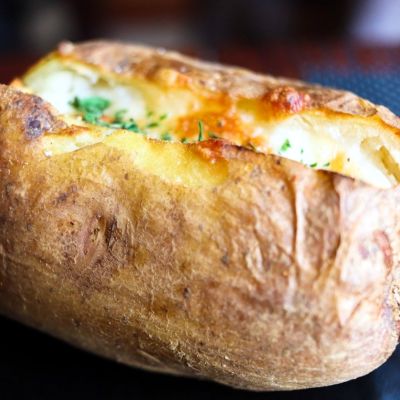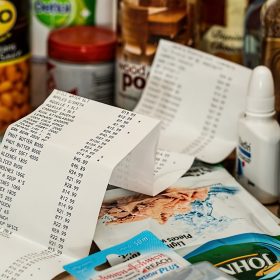Baked Potatoes 101, & Variations on the Theme
Oh, the simple pleasure of one of the world’s best comfort foods: a hot baked potato with melting butter, sour cream, and chives.
I have a tip that can put those tender, melty goodies on your table a little faster, or with a few fun and very simple twists.
A basic baked potato uses a russet potato of 5 to 12 ounces. Russets make the lightest, fluffiest version, because they start out just a little drier on the inside. I sometimes prefer Yukon Gold potatoes, which are denser, moister, and taste like butter before you even add any. It’s a little harder to find them in large sizes, though, at least around where I live.
With either kind of potato, scrub them clean, and then poke a couple of holes on two sides with a fork or sharp knife. The holes are needed as vents, so that your potatoes won’t explode from steam pressure. Then throw them in a preheated 375° oven for about 90 minutes. They’re done when the outside is crispy and they give when you squeeze them.
And there’s what I consider to be the only problem with baked potatoes. I don’t usually know I’m craving that buttery goodness that far ahead of dinner time. So here’s a tip: poke those holes in the potato, and microwave it on high for about 6-8 minutes (depending on size), turning it over halfway through the cooking time. When the sides give slightly when the potato is gently squeezed (USE A HOTPAD!!), take them out and give them 15 – 20 minutes in a preheated 400° oven (I use a toaster oven), to crisp up the outside. For more potatoes, just increase the time in the microwave, using the squeeze test for doneness. When cooked this way, they won’t be quite as fluffy as when they spend 90 minutes in the oven, but you won’t care about the difference when you’re enjoying your hot, creamy treat.
If you like your potato skins tender, rather than chewy, spread oil of your choice on the outside, sprinkle it with a little salt, and wrap it in foil before whatever part of the baking you do in the oven.
And I have a fun new way for you to try your baked potato. My mother always did something that I belatedly realized most people consider odd: she peeled them before baking. She doesn’t like the skin! Crazy, I know, but I was brought up on skinless potatoes. And I loved them that way, because something wonderful happens to peeled potatoes baked in a hot oven — they grow a new skin. The outside dries out and bakes into something wonderfully chewy-crisp to eat separately from the fluffy insides.
When I choose to peel away that nutritious skin before baking, I assuage my guilt by really reveling in the decadence of cutting the baked potato in half in the short direction, scooping all the potato insides out onto my plate (this I decorate as usual, with butter, sour cream, salt, chives), and then putting a small pat of butter into each empty half-“skin” with a little salt, pinching the top closed, and eating those pockets as finger food while the melted butter drips down my chin. They’re sturdier than real potato skins, and eye-rollingly good.
You can easily convert your baked potato into a complete meal. I’m sure you already know that adding chopped bacon and shredded cheddar will load it up, but you can also add some warm, seasoned black beans to the top. A little cumin or chili powder in the beans will put a bright edge on a meal now packed with protein. Or top your buttery potato with some sliced mushrooms that you sautéed with chopped garlic or shallots in a little butter and white wine. As I’m writing this, I realize some cooked green peas could also make a nice sort of sweet topping that your teeth might enjoy popping open.
I’m not saying to use these goodies instead of the butter, sour cream, and chives, but in addition. I suppose if you like tofu, you could put that on there…. Me, I’m not looking for a baked potato quite that good for me. Using any or all of these ideas, you can create a nutritious meal with as much decadence as you dare.






